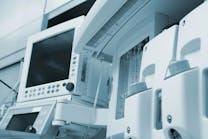Smart Handling of Scopes Saves Time and Money While Safeguarding Care
While essential for patient care, endoscopes tend to get a bad rap when it comes to reprocessing and maintenance. Their complexity is a double-edged sword: facilitating advanced procedures, including screening, diagnosis, and treatment, but necessitating a multitude of steps to effectively and safely reprocess.
Considering these challenges, HPN presents the story of how Nemours Children's Hospital, Delaware, minimized complexities and costs associated with reprocessing unused endoscopes.
Additionally, Hannah Schroeder, BSHA, CRCST, CHL, CIS, CER, clinical education specialist, Pure Processing, offers her insights on endoscope cleaning.
Lastly, Michael Matthews, MBA, CLSSGB, Director of Customer Training and Education at Agiliti, and Tom Milano, president and COO, Encore Medical Device Repair, share best practices for protecting endoscope assets.
Collaboration pays off for Nemours Children's Hospital, Delaware
With its commitment to patient care and safety, Nemours Children's Hospital established a 7-day hang time for unused endoscopes, meaning that after the seventh day in storage, the endoscopes must be reprocessed.
The weekly reprocessing of unused scopes presented labor and cost burdens. The sterile processing (SP) team spent hundreds of hours each year on the reprocessing, and the hospital spent significant money on consumables (e.g., detergent, PPE, disinfectant), not to mention the costs associated with wear and tear on the scopes.
Edna Gilliam, DNP, MBA, RN, CNOR, NEA-BC, assistant vice president, Perioperative Services & SPD, DV, Nemours Children's Hospital, recalled, “Someone in either the SP department (SPD) or infection prevention (IP) asked the question, ‘why do we have to do this every 7 days?’”
This prompted an intensive multidisciplinary initiative led by the SP, IP, and perioperative services teams to double the time between reprocessing unused scopes, from every 7 to every 14 days. But before the change could be made, they had to prove it would not negatively impact patient care and safety.
The team was led by Gilliam, Nemours Children's Hospital’s SPD Manager Kwame Addomah Gyabaah, MHA, Mini MBA, BS, ACHE, CHL, CER, CIS, CRCST, and the hospital’s Infection Prevention and Control Director Meg Feeney Gilman, MAS, CIC, FAPIC.
The investigation
Gilliam, Gyabaah, and Gilman began their research to determine where the 7-day rule originated, starting with the American National Standards Institute (ANSI)/Advancement of Medical Instrumentation (AAMI) ST91:2021 Flexible and semi-rigid endoscope processing in healthcare facilities standard.
“AAMI’s recommendation to determine time between unused scope processing was to follow the endoscope manufacturers’ instructions for use (IFU) or perform a multidisciplinary risk assessment,” Feeney Gilman explained. “Because the IFUs didn’t provide a hang time, we proceeded with the assessment to compare reprocessing every seven days versus every 14 days.”
Using AAMI guidance, the team completed the risk assessment, scouring standards and published research for evidence to support the proposed change. They presented their assessment to Nemours Children's Hospital’s infection prevention and control committee, which is comprised of not just IP professionals, but other clinical stakeholders as well, including representatives from the gastrointestinal (GI) and respiratory teams, the director of surgical operations, and outpatient services.
The response
“In that first meeting with the infection prevention and control committee, there were a lot of questions,” said Gilliam. “One reason is the lack of a standard for the unused scope reprocessing timeframe. In perioperative services, we can go to the Association of periOperative Registered Nurses (AORN), which is very specific with their guidelines and best practices. The committee members wanted to see something similar from AAMI on the scopes, but it just wasn’t there.”
“It all came down to the quality assurance piece,” Gilliam continued. “The committee wanted us to show how this move was beneficial to our organization, but more importantly, to our patients, staff members, and equipment. With their feedback, we were able to come back together as a team and make that quality assurance argument even stronger.”
Building the case for quality assurance
Gilliam, Gyabaah, and Gilman developed a process for random culturing of unused scopes in the SPD, which was approved by the infection prevention and control committee for a 3-month trial.
“After the unused scopes passed the 7-day expiration period based on hospital policy and were presented for reprocessing, we swabbed them to test for protein buildup,” Gyabaah explained. “We did this for 3 months, recording the results in our SPM system.”
“We did not see any protein buildup on the tested scopes and did not identify any adverse outcomes in our patients through either our electronic surveillance system or our patient safety and risk system,” Gilman commented.
“We gathered the data and information and presented it to the infection prevention and control committee,” said Gyabaah. “At that time, they granted approval for a house-wide policy change from seven to 14 days.”
The results
Gilliam, Gyabaah, and Gilman engaged Nemours Children's Hospital’s supply chain team to calculate consumable supply savings from the change.
“Together, we pulled figures for the supplies we were using before and after the three-month pilot period, including enzymatic detergent, personal protective equipment (PPE), and high-level disinfectant,” said Gilman. “To this, we added an estimated SP labor savings. From there, we extrapolated the consumable and labor savings over the three months for an estimated annual savings.”
The team determined the extension of unused scope reprocessing from seven to 14 days saves Nemours Children's Hospital approximately $150,000 per year, including 576 hours of SP staff time.
“All the work the SPD team did during the three-month pilot to test the scopes and track the results really paid off,” said Gyabaah. “The switch to the 14-day reprocessing cycle definitely means less work on our part.”
Lessons learned and advice for others
When asked for their key lessons learned through the initiative, Gilliam, Gyabaah, and Gilman offered this advice to others wanting to make a similar change.
Don’t go it alone
Gilliam stressed how the multidisciplinary approach was critical to the initiative’s success, stating:
“Having everyone at the table from the very beginning was necessary because everyone looks at things from a different lens. We were able to engage in conversations, address concerns and questions, and move forward with confidence knowing we were all in this together.”
Gilman added how she found it beneficial for her team to work with Kwame and the SP team in a different way, stating:
“The nature of our work in infection prevention is to be problem finders; therefore, our presence in the SPD and elsewhere in the hospital is often not welcome. Kwame and I had a good relationship before, but working together on this project has strengthened it even more. I think we’ve come to see each other's perspectives a little bit more clearly. And support from Edna and surgical services was vital.”
“It’s a great partnership,” said Gyabaah. “Given their role as problem finders, rounding in the SPD with infection prevention helps keep us on our toes as they can identify things we might have overlooked. We had a visit from The Joint Commission (TJC) not too long ago and Meg and her team were great partners in helping us prepare for that as well.”
Do your legwork ahead of time
Gilman echoed Gilliam’s comment on engaging stakeholders from the beginning and added how her work with Gilliam and Gyabaah to do the research and establish the case ahead of time before meeting with the infection prevention and control committee paved a more positive path forward.
“That is something I really want to drive home: if you do the legwork ahead of time the rest is, I wouldn’t say ‘easy’ because it’s not easy, but it’s easier,” she stated. “By reviewing hundreds of pages of standards and guidelines, performing the risk analysis, creating a proposal for the body that has oversight of this work, and securing their approval, everything was ready to go when Gyabaah and the SP team were ready to enact the change.”
Leverage the power of data
Gyabaah pointed to the power of data when enacting change, stating:
“It was not an easy decision to change our reprocessing policy but the data from our pilot spoke volumes. It played a key role in convincing stakeholders that the move from seven to 14 days would not adversely impact patient care and safety.”
“We are so fortunate that we have Kwame with his ability to leverage technology in a way that not only captured the evidence but also presented it in a way that was easy for stakeholders to understand,” said Gilman.
Endoscope cleaning considerations
Collaboration and communication among those departments and individuals responsible for endoscope reprocessing is critical to minimizing variations that impact quality. Standardization starts with endoscope cleaning, according to Hannah Schroeder, BSHA, CRCST, CHL, CIS, CER, Clinical Education Specialist, Pure Processing. She stated:
“Manual cleaning practices and available tools, technicians’ competency, and how technicians conduct their testing are all attributors to variance in endoscope reprocessing and cleaning verification. We are seeing reputable studies being published that speak to the consequences that come from variance in practices and it starts before test sampling.”
Schroeder pointed out how “automated processes help reduce human error, provide consistent and repeatable processes, and enhance cleaning results with calibrated pressure output and higher volumes of cleaning solution.” As for those aspects of endoscope reprocessing that necessitate manual intervention, she said there is growing awareness for the need to evaluate technology and techniques.
“More recently, endoscope brushes are seeing new innovations, including specialized, validated brushes that have proven results to improve channel cleaning of flexible endoscope channels,” said Schroeder. “With improved technology, materials, and designs, these brushes adapt to the wear and tear of reusable endoscope channels, while also relieving some of the repetitiveness that can lead to staff fatigue and added labor.”
Protecting endoscope assets
Proper reprocessing, storage, and maintenance of endoscopes not only protects patients but also serves to protect the endoscopes themselves.
“Improperly cleaned endoscopes and damaged endoscopes are connected issues,” said Michael Matthews, MBA, CLSSGB, Director of Customer Training and Education at Agiliti. “When manufacturers originally design endoscope cleaning instructions, they are intended to be used with a fully functioning device. The instructions are important for reducing infection risk as part of reprocessing, but they will not be effective if the endoscope is already damaged.”
Tom Milano, president and COO, Encore Medical Device Repair, commented on the topic, offering his advice to healthcare organizations.
“Endoscopes are vital for patient care in U.S. hospitals, but they are also expensive to acquire ($40,000 or more) and maintain,” said Milano. “In some hospitals, the endoscopes budget is a million dollars or more.”
Milano pointed out how endoscopes are delicate instruments that break easily if not appropriately protected and serviced. “The original manufacturer typically offers a service contract that is often 20-30% of the price of the endoscope itself,” he commented. “However, third-party vendors play a major role in the system because they can typically service the entire portfolio of endoscopes and offer a price advantage.”
“Unfortunately, scope damage is often overlooked by end-users because they are only flagged as ‘damaged’ when the scope no longer functions as expected during the procedure,” said Matthews.
“The reality is that a scope can be damaged in subtle ways that make it difficult to clean properly,” Matthews continued. “For example, gouges in the distal tip or scratches in the biopsy channel will likely have no meaningful impact on the scope’s performance during the procedure, but both types of damage will create areas where bioburden will become embedded into a biofilm. This can make the cleaning process ineffective and leave facilities with contaminated endoscopes in circulation.”
SP staff education and training
According to Matthews, damage prevention begins with education. He stated:
“Many technicians have not been trained on early warning signs of damage that indicate a scope may not be able to be cleaned effectively. Unless a facility has a robust inspection and quality-assurance program that emphasizes preventive identification of damage, it is likely that their scopes are damaged already – and their patients are at greater risk.”
“Leaders should ensure their technicians receive training on how to effectively identify types of endoscope damage that can jeopardize the effectiveness of the cleaning process – and what’s causing the damage,” he added.
Matthews also noted how technicians must be given the time necessary to properly examine an endoscope during reprocessing.
“Every time a scope is handled, it could have been damaged,” he explained. “Based on the new endoscope reprocessing standard ANSI/AAMI ST91:2021, thorough inspection must be part of the regular reprocessing cycle. Unfortunately, many technicians are under pressure to reprocess scopes within tight timeframes, which makes it challenging to follow the appropriate device cleaning instructions and carefully inspect each scope for damage. To put technicians and patients in the best position, make sure technicians have enough time for effective cleaning, damage inspection, and education and training.”
Industry partners
Milano described the endoscope repair and maintenance industry as “dysfunctional,” noting how “hospitals usually spend more than they should on less than they deserve.”
“Repair and service quality is often not impressive, services are not adequate for the training and maintenance needs of the healthcare facility, prices are not transparent, turn-around times are long, and endoscopes that could be repaired are unnecessarily discarded, forcing hospitals to spend large amounts of money acquiring new endoscopes,” he stated. “Service contracts requiring hospitals to pay for ‘over-consumption’ usually lead to exaggerated, unnecessary spend levels.”
Milano believes healthcare facilities need to raise their expectations for endoscope maintenance partners, stating:
“Those partners should be invested in the preventative process that enables maximum equipment lifetime and minimum hospital costs – not in invoicing repair after repair. Pricing needs to be transparent and fair, and the quality of maintenance and repair technologists needs to be consistent and high. The industry, including healthcare facilities, would benefit from a certification program that ensured not only technically adequate training, but also training focused on how to prevent repairs through proper handling.”
Matthews spoke to the importance of auditing, data documentation, and continuous improvement, stating:
“As a starting point, leaders should partner with a repair vendor to help them understand their unique challenges and opportunities for improvement. Data from the repair vendor is critical to targeting possible sources of damage so leaders can focus their attention and efforts on the most significant opportunities. Leaders should also make a regular practice of auditing their process and documenting their findings. Regular auditing, along with repair data, is key to making sustained, incremental improvements and establishing a culture of constant process improvement.”

Kara Nadeau | Senior Contributing Editor
Kara Nadeau is Sterile Processing Editor for Healthcare Purchasing News.















